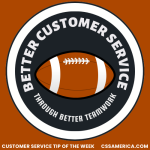Here are two customer retention concepts that we discuss with some sports clients: BIRG and CORF. BIRG is Basking In Reflected Glory. CORF is Cutting Off Reflected Failure.
You want BIRG. You want the customers feeling so good about your organization that they want to be a part of your organization, they want to let others know they’re a customer of your business.
You don’t want CORF. This is where it’s the “in thing” to talk negatively about an organization. Customers go out of their way to say they’re not affiliated with or not a customer of an organization.
So, how could any one of us as an individual help to create BIRG – that positivity about our organization in the customer’s mind? Obviously, every encounter, every communication, every Moment of Truth is an opportunity to create BIRG. But there are also opportunities to create these positive feelings from your customers in what you say about your company.
Talk positively about what the company has now: You could describe the great website that has all of this excellent information or enables the customer to get their needs met on their own.
Talk positively about the company’s future: You could use an important communication vehicle from our sports clients – communicating the “Direction of the Team.” This is where you talk about the company’s vision. You could mention the expansion plans, the community initiatives they have underway, renovations that will take place, or new products and services on the horizon.
Talk about the customer’s role in the company’s success: State “When you, Mr. Customer, do ABC like you did, that really helps us out. We are here to serve our customers, so thanks for the opportunity to do so. Our company would not be nearly as successful if it wasn’t for great clients such as yourself.”
Talk about your feelings working for the company: Mention that you’ve worked there for 10 years because it’s a company with good values. You enjoy working there, and it’s amazing how the company gives you the training and tools you need to do a good job. You could mention how it’s great to work for a company who listens to your ideas and is always trying to get better.
If we want our customers feeling good about our companies, think about what you can do to talk positively about your company’s present, its plans for the future, the customer’s role in its success, and what you like best about working there.
Build up the BIRG.
Signup for FREE Tips! Contact Us More Resources for You Visit Our Home Page
























